Lisa Sachs's Blog, page 7
June 23, 2016
Walking the Trail of Woman's History
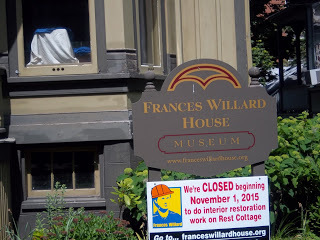 With Hillary Clinton presumably becoming the first woman to run for president from either major political party, it’s good to refresh our memories about all the efforts that came before to make her candidacy possible. The Evanston History Center gives walking tours of the historic points in Evanstonian women’s history and I am very glad that I joined them for that walk on Saturday June 18th. Most of the Evanston History Center’s historic tours begin at the Evanston History Center, 225 Greenwood Street, Evanston, Illinois but this one began on the lawn of the Frances Willard House.
With Hillary Clinton presumably becoming the first woman to run for president from either major political party, it’s good to refresh our memories about all the efforts that came before to make her candidacy possible. The Evanston History Center gives walking tours of the historic points in Evanstonian women’s history and I am very glad that I joined them for that walk on Saturday June 18th. Most of the Evanston History Center’s historic tours begin at the Evanston History Center, 225 Greenwood Street, Evanston, Illinois but this one began on the lawn of the Frances Willard House.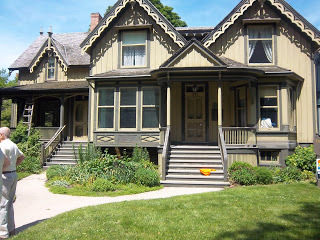 The Frances Willard House
The Frances Willard HouseBesides learning more about Frances Willard, I learned about the women’s history of Evanston. Evanston grew up around Northwestern University, a college that was associated with the Methodist Church and preached abstinence. Women were welcomed in Evanston as both college students and career women as early as the 1860’s. Northwestern University became the third university in the United States to become coed in 1870 after Oberlin and Antioch.
Because of the atmosphere created in Evanston encouraging women to have educations and careers, many dynamic women moved to Evanston in the late 1800’s. On the walking tour, we saw the houses of many who had lived in Evanston and made important contributions to women’s history. We were told that the Evanston History Center has many documents about these women’s lives that are available for reading there. I plan to go there and research this in more depth as the other women whose houses we also saw on the walking tour are too numerous to mention here.
With Hillary Clinton presumably getting the Democratic nomination we see how far we have come and how much further we still have to go. I have to say, however, that we got there behind numerous other countries that have elected women heads of state long before this. Some that come to mind are Germany, England, Costa Rica, Chile, Argentina, Brazil, Israel, India, and Pakistan just to name a few. And this history tour reminded me that it didn’t happen here in the United States or anywhere else by accident. Women have been working on it for more than a century. It’s about time.
Published on June 23, 2016 06:22
June 16, 2016
Traveling in Chicago - The Chicago Botanical Garden
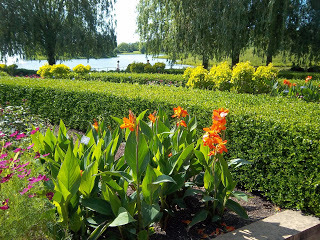
This week more than ever, a visit to The Chicago Botanical Garden seemed like a great idea. The carnage in Orlando and the venom that has been spewed since against immigrants especially Muslims goes on and on. I could talk about acceptance – of the LGBT community, of Muslims, and of other immigrants- but you’ve heard it all before. I could talk about sensible gun control, but I’ve done that before also. Pres. Obama made his sixteenth impassioned plea for gun control probably to no avail. Sometimes it feels good to just take a break.
I can’t think of a better place for a break than the Chicago Botanic Garden www.chicagobotanic.org located at the Edens Expressway and Lake-Cook Road in Glencoe, Illinois. It’s listed as a major museum in Chicago’s Museums, A Complete Guide to the City’s Cultural Attractions by Victor Danilov. Every time we go there we see new gardens and more in bloom. Admission to the Botanic Garden is free but the charge for parking is $25 per car. It is open daily.
Going there in June there is so much blooming. Instead of deluging you with more words, here are some of my favorite pictures. I fervently hope that all of us individually and America as a whole has a better week ahead.

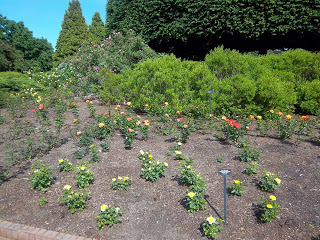 rose garden
rose garden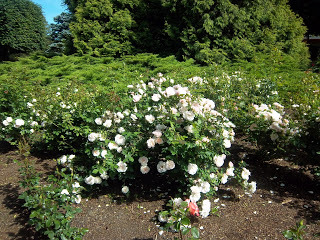 rose garden
rose garden English Garden
English Garden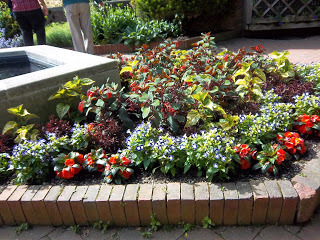 In the sensory garden
In the sensory garden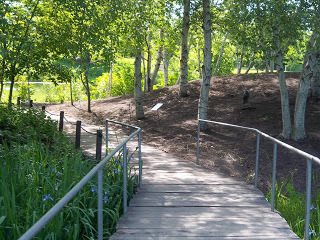 walk to Spider Island
walk to Spider Island
Published on June 16, 2016 06:00
June 9, 2016
Traveling in Chicago - the Mary and Leigh Block Travel Museum
One of the many good things about traveling in Chicago is that there is always something new to see. This day, however, was a beautiful one and I wanted to see the Lakefront. We have to enjoy every nice summer day that comes here to us.
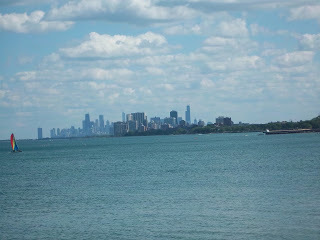 viewing the Chicago skyline from the Evanston Lakefront
viewing the Chicago skyline from the Evanston Lakefront
In Chicago’s Museums, A Complete Guide to the City’s Cultural Attractions, Danilov lists the Mary and Leigh Block Museum. Part of Northwestern University’s Campus, it is located on the Arts Circle and is open daily except Monday. Admission is free.
When Danilov wrote his book, the Block Museum was relatively new. It opened 36 years ago and has since become an integral part of the college campus. Besides its art exhibits, they have a film museum that shows a wide variety of films and seminars about film.
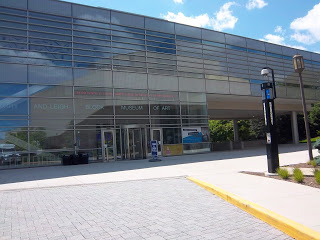 The Mary and Leigh Block Museum
The Mary and Leigh Block Museum
While the Block Museum has a collection of over 5,000 pieces of art, their exhibitions are temporary. At this time, the works in their sculpture garden are being restored and unavailable for viewing.
The main exhibit right now is “A Feast of Astonishments” by Charlotte Moorman. This amazing woman began her career in Little Rock, Arkansas studying to be a classic cellist. She soon got caught up in the Avant Garde Movement and moved to New York. She is mostly remembered for organizing the Avant Garde festivals in New York City from the 1960’s to 1980’s. The exhibit consists of photographs, macramé, performance art recorded on video, and collections of things that she collected. I saw videos of her playing her cello in midair and one of her talking about being arrested and jailed for giving a cello concert in the nude. Charlotte Moorman believed that art should be a blending of all the art forms and this she tried to do. In the process, she became involved with people in every avenue of the arts.
Charlotte Moorman developed breast cancer in the 1970’s and became less able to be involved in the art world. She retreated increasingly into her house writing several journals that are on display in this exhibit. My favorite part of the exhibit was the room where all her collections were stored in boxes. Before dieing, she left her husband the instructions “Don’t throw anything out.” While some things were undoubtedly pitched, there was plenty left behind giving new meaning to the term packrat. I’ll think twice before I call anyone a hoarder again. At least most people don’t try to leave their stuff for posterity.
I can’t say that I liked this exhibit but it certainly gives one something to think about. Charlotte Moorman challenged the prevailing assumptions of her time inviting all to expand their minds. Her exhibit will be there at the Block Museum through July 25th. Go see it if you dare.

 viewing the Chicago skyline from the Evanston Lakefront
viewing the Chicago skyline from the Evanston LakefrontIn Chicago’s Museums, A Complete Guide to the City’s Cultural Attractions, Danilov lists the Mary and Leigh Block Museum. Part of Northwestern University’s Campus, it is located on the Arts Circle and is open daily except Monday. Admission is free.
When Danilov wrote his book, the Block Museum was relatively new. It opened 36 years ago and has since become an integral part of the college campus. Besides its art exhibits, they have a film museum that shows a wide variety of films and seminars about film.
 The Mary and Leigh Block Museum
The Mary and Leigh Block MuseumWhile the Block Museum has a collection of over 5,000 pieces of art, their exhibitions are temporary. At this time, the works in their sculpture garden are being restored and unavailable for viewing.
The main exhibit right now is “A Feast of Astonishments” by Charlotte Moorman. This amazing woman began her career in Little Rock, Arkansas studying to be a classic cellist. She soon got caught up in the Avant Garde Movement and moved to New York. She is mostly remembered for organizing the Avant Garde festivals in New York City from the 1960’s to 1980’s. The exhibit consists of photographs, macramé, performance art recorded on video, and collections of things that she collected. I saw videos of her playing her cello in midair and one of her talking about being arrested and jailed for giving a cello concert in the nude. Charlotte Moorman believed that art should be a blending of all the art forms and this she tried to do. In the process, she became involved with people in every avenue of the arts.
Charlotte Moorman developed breast cancer in the 1970’s and became less able to be involved in the art world. She retreated increasingly into her house writing several journals that are on display in this exhibit. My favorite part of the exhibit was the room where all her collections were stored in boxes. Before dieing, she left her husband the instructions “Don’t throw anything out.” While some things were undoubtedly pitched, there was plenty left behind giving new meaning to the term packrat. I’ll think twice before I call anyone a hoarder again. At least most people don’t try to leave their stuff for posterity.
I can’t say that I liked this exhibit but it certainly gives one something to think about. Charlotte Moorman challenged the prevailing assumptions of her time inviting all to expand their minds. Her exhibit will be there at the Block Museum through July 25th. Go see it if you dare.

Published on June 09, 2016 06:00
June 2, 2016
California - See It Now
We had a great time in California but there are some good things about coming back to Chicago. I knew I was back in the Midwest when we went to a restaurant here and the waiter brought a pitcher of ice water to our table without being asked. It’s a small thing that too many of us take for granted. We shouldn’t. Drought and other conditions caused by climate change are here to stay. Right. I’m “no scientist” but it seems to be evident with the many natural disasters that have been occurring almost weekly. People in California have begun to adapt to some extent. Despite all the grass being watered, there seemed to be more succulent plants growing than when we were last there. Hopefully, people will be planting them more often. Nevertheless, for me, it was an enjoyable change of pace. We don’t see those types of plants in the Midwest.
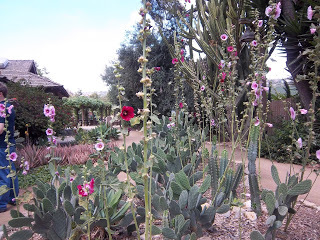 succulent plants in the Rios District of San Juan Capistrano
succulent plants in the Rios District of San Juan Capistrano
Before going to California, I had worried how I would handle the drought. Fortunately, water isn’t being rationed there yet and in most restaurants, was available on request. At one restaurant, we were given a card reminding us of California’s five-year drought and telling us to specify exactly how much water we were going to consume. They didn’t want to bring us an ounce more than that.
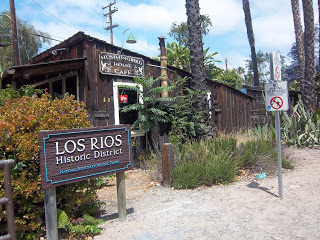
Despite the water problem, we had a beautiful time in California visiting family. We spent a few days in San Clemente and beach towns near it and a couple of days in San Diego. We were warned that we were arriving in the middle of the May Grays. Every morning began with gray, cloudy skies but by late morning or early afternoon, the sky was blue and beautifully cloudless. The beach invited us in. Surfers surfed in wet suits and some children actually swam in the water in bathing suits. It was too cold for me to swim, but I got some good pictures of the coast that I’ll share with you now.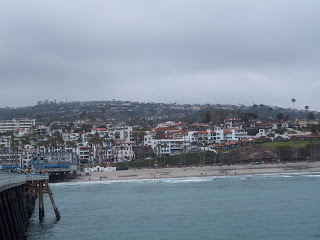
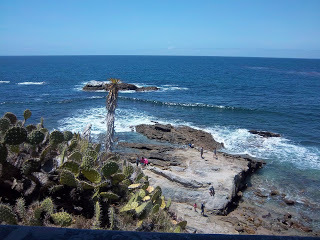
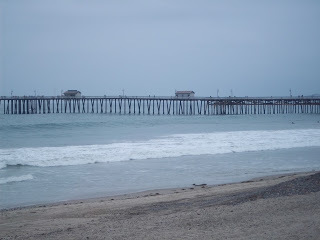
In San Diego, we had a wonderful day at Balboa Park. This is probably San Diego’s gem and if you’re ever there, you should pay it a visit. Seventeen museums are housed there as well as Spanish Village, an open area where artists and artists have their studios. There are several theaters as well. All of it is done in Spanish Rococo architecture.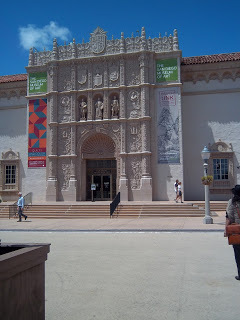
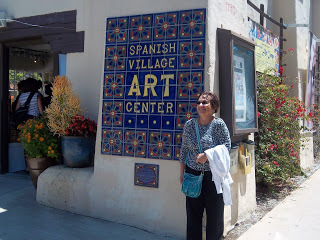
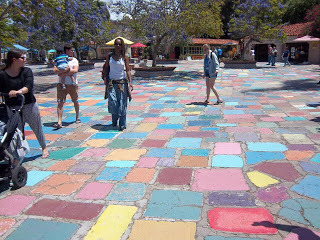
Balboa Park has gardens of several types. We enjoyed the Desert Garden especially. It is next door to the Rose Garden. We visited that as well, but we can see roses any time. It isn’t often that we get to see so many varieties of cacti and other desert plants and other succulents.
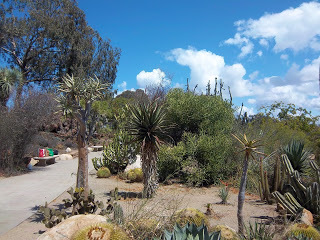 Desert Garden in Balboa Park
Desert Garden in Balboa Park
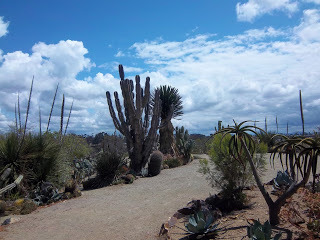 Desert Garden
Desert Garden
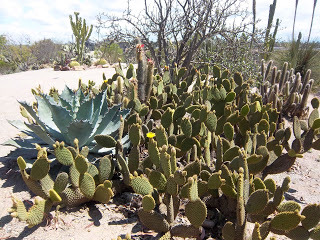 Desert GardenThis was our first trip to California in a long while. We saw a lot more but there isn't space to talk about all of it. Now that we’ve been there, I’m sure I’ll look forward to returning for a visit another time.
Desert GardenThis was our first trip to California in a long while. We saw a lot more but there isn't space to talk about all of it. Now that we’ve been there, I’m sure I’ll look forward to returning for a visit another time.
 succulent plants in the Rios District of San Juan Capistrano
succulent plants in the Rios District of San Juan CapistranoBefore going to California, I had worried how I would handle the drought. Fortunately, water isn’t being rationed there yet and in most restaurants, was available on request. At one restaurant, we were given a card reminding us of California’s five-year drought and telling us to specify exactly how much water we were going to consume. They didn’t want to bring us an ounce more than that.

Despite the water problem, we had a beautiful time in California visiting family. We spent a few days in San Clemente and beach towns near it and a couple of days in San Diego. We were warned that we were arriving in the middle of the May Grays. Every morning began with gray, cloudy skies but by late morning or early afternoon, the sky was blue and beautifully cloudless. The beach invited us in. Surfers surfed in wet suits and some children actually swam in the water in bathing suits. It was too cold for me to swim, but I got some good pictures of the coast that I’ll share with you now.



In San Diego, we had a wonderful day at Balboa Park. This is probably San Diego’s gem and if you’re ever there, you should pay it a visit. Seventeen museums are housed there as well as Spanish Village, an open area where artists and artists have their studios. There are several theaters as well. All of it is done in Spanish Rococo architecture.



Balboa Park has gardens of several types. We enjoyed the Desert Garden especially. It is next door to the Rose Garden. We visited that as well, but we can see roses any time. It isn’t often that we get to see so many varieties of cacti and other desert plants and other succulents.
 Desert Garden in Balboa Park
Desert Garden in Balboa Park Desert Garden
Desert Garden Desert GardenThis was our first trip to California in a long while. We saw a lot more but there isn't space to talk about all of it. Now that we’ve been there, I’m sure I’ll look forward to returning for a visit another time.
Desert GardenThis was our first trip to California in a long while. We saw a lot more but there isn't space to talk about all of it. Now that we’ve been there, I’m sure I’ll look forward to returning for a visit another time.
Published on June 02, 2016 08:06
May 26, 2016
Travel in Chicago - Skokie's 26th Annual Festival of Cultures
It was a beautiful day for traveling. The sun shone and the temperature was warm. Arriving at Skokie’s 26th Festival of Cultures, we were given “passports.” The inside pages listed the 36 communities participating this year. We were excited to get started. Here in our backyard every year, we can feel as though we are traveling around the world.
Skokie, a suburb adjacent to Chicago, has a population of about 70,000 people of which about 55% speak a first language other than English. Immigrants from all over the world live here and over 70 languages are spoken. Twenty-six years ago, the Skokie Public Library along with the Park District and other organizations initiated this festival. As the community was becoming multi-cultural, they felt it was important to not only tolerate diversity, but to embrace it. Every year since then, the community has been coming together to celebrate its diversity at this Festival of Cultures. After all, once we’ve watched each other’s dances, sang each other’s songs, heard one another’s music, and tasted each other’s food, it is impossible to be strangers.
At the main stage, we watched the Serbian-Macedonian Dancers.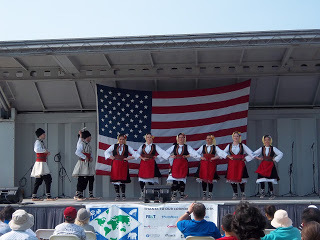 Serbian-Macedonian Dancers
Serbian-Macedonian Dancers
Making our way to the booths, we stopped and talked to people from Norway, Sweden, Cuba, Ireland, Bangladesh, Croatia, and Bulgaria. If we had been to people’s countries, they were excited to hear about our travels. If we had plans to visit, they asked us to come back next year and tell them about our trip. Children came by and had their visas stamped. It was a good day for travel for them as well.
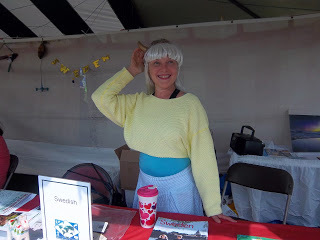 At the Swedish booth
At the Swedish booth
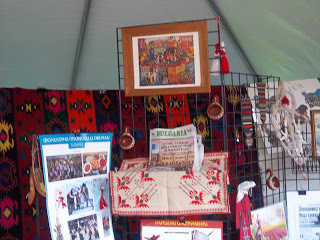 Bulgarian booth
Bulgarian booth
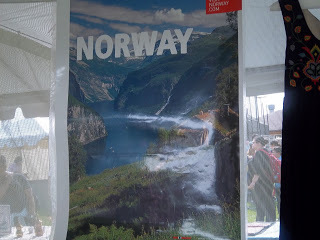
After exploring the booths, we returned to the main stage. We listened to a band from West Africa, and watched dancers from India and Bulgaria. I took pictures of the performers and was glad to see that everyone in the audience regardless of their ethnicity took pictures of everyone else. I like to interpret that as success. With that in mind, we went home to eat Greek salad and keftedes. Next year we will return to talk to people from other countries around the world. Who knows who we’ll meet next time.
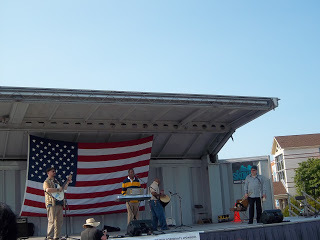 West African Band
West African Band
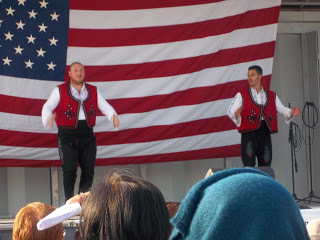 Bulgarian dancers
Bulgarian dancers
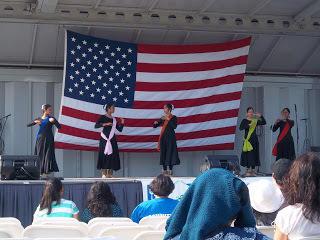 Indian dancers
Indian dancers
Skokie, a suburb adjacent to Chicago, has a population of about 70,000 people of which about 55% speak a first language other than English. Immigrants from all over the world live here and over 70 languages are spoken. Twenty-six years ago, the Skokie Public Library along with the Park District and other organizations initiated this festival. As the community was becoming multi-cultural, they felt it was important to not only tolerate diversity, but to embrace it. Every year since then, the community has been coming together to celebrate its diversity at this Festival of Cultures. After all, once we’ve watched each other’s dances, sang each other’s songs, heard one another’s music, and tasted each other’s food, it is impossible to be strangers.
At the main stage, we watched the Serbian-Macedonian Dancers.
 Serbian-Macedonian Dancers
Serbian-Macedonian DancersMaking our way to the booths, we stopped and talked to people from Norway, Sweden, Cuba, Ireland, Bangladesh, Croatia, and Bulgaria. If we had been to people’s countries, they were excited to hear about our travels. If we had plans to visit, they asked us to come back next year and tell them about our trip. Children came by and had their visas stamped. It was a good day for travel for them as well.
 At the Swedish booth
At the Swedish booth Bulgarian booth
Bulgarian booth 
After exploring the booths, we returned to the main stage. We listened to a band from West Africa, and watched dancers from India and Bulgaria. I took pictures of the performers and was glad to see that everyone in the audience regardless of their ethnicity took pictures of everyone else. I like to interpret that as success. With that in mind, we went home to eat Greek salad and keftedes. Next year we will return to talk to people from other countries around the world. Who knows who we’ll meet next time.
 West African Band
West African Band Bulgarian dancers
Bulgarian dancers Indian dancers
Indian dancers
Published on May 26, 2016 06:00
May 19, 2016
Traveling Chicago - Sunday at the Art Institute
If someone has only three hours to see Chicago and asks you what to do with those three hours, what would you suggest? The Art Institute www.artinstitute.org , founded in 1879, would definitely be one of my top choices. You can't miss it. It's in downtown Chicago on Michigan Avenue and Adams. Victor J. Danilov lists the Art Institute as one of Chicago’s big three museums in his book Chicago’s Museums – A Complete Guide to the City’s Cultural Attractions. Without a doubt, the Art Institute deserves this billing.
Our friends had just about three hours before having to head to the airport and they wanted to go to the Art Institute. It’s fun going with other people. Although one can see any type of art at the Art Institute, it is particularly noted for its Impressionist collection. We often gravitate to the Impressionists when we go there. When we have company, though, we ask our guests what they want to see. On another visit, friends asked to see the Asian paintings and that’s where we went. For the first time, I saw these paintings first instead of on my way out. I realized how beautiful this art was with its fine delicate lines. I promised myself that I would return to this section to admire it again and I have been there several times.
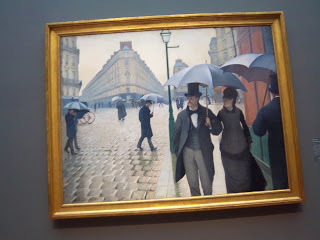 Paris Street; Rainy Day by Gustave CaillebotteThis Sunday our friends preferred the contemporary artists. We followed a path in that direction. The first painting that caught our eyes was the Gustave Caillebotte painting Paris Street;Rainy Day. We usually start at that room. This work always stands out as you enter it and it was good to see it again like seeing an old friend. After that, we took a different path toward the moderns.
Paris Street; Rainy Day by Gustave CaillebotteThis Sunday our friends preferred the contemporary artists. We followed a path in that direction. The first painting that caught our eyes was the Gustave Caillebotte painting Paris Street;Rainy Day. We usually start at that room. This work always stands out as you enter it and it was good to see it again like seeing an old friend. After that, we took a different path toward the moderns.
As we walked on, we saw a large variety of art. DeKooning, Klee, Feininger, Miro, Kandinsky, and Marc Chagall just to name a few. It’s impossible to go to the Art Institute and be disappointed. Especially since the new wing was built, their collection is vast and has art to suit everyone's preferences. I look forward to going with other guests and discovering what art they like. It’s a great way to expand your ideas. In the meantime, here’s a peak into some of the paintings that we saw this time.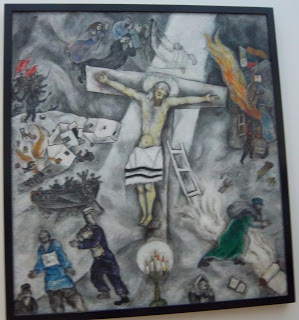 White Crucifixion by Marc Chagall
White Crucifixion by Marc Chagall
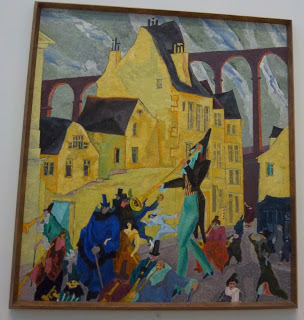 Carnival in Arcueil by Lyonel Feininger
Carnival in Arcueil by Lyonel Feininger
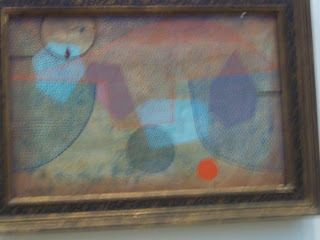
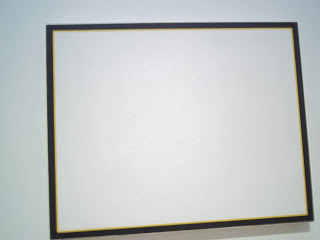
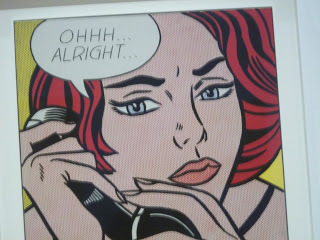
Our friends had just about three hours before having to head to the airport and they wanted to go to the Art Institute. It’s fun going with other people. Although one can see any type of art at the Art Institute, it is particularly noted for its Impressionist collection. We often gravitate to the Impressionists when we go there. When we have company, though, we ask our guests what they want to see. On another visit, friends asked to see the Asian paintings and that’s where we went. For the first time, I saw these paintings first instead of on my way out. I realized how beautiful this art was with its fine delicate lines. I promised myself that I would return to this section to admire it again and I have been there several times.
 Paris Street; Rainy Day by Gustave CaillebotteThis Sunday our friends preferred the contemporary artists. We followed a path in that direction. The first painting that caught our eyes was the Gustave Caillebotte painting Paris Street;Rainy Day. We usually start at that room. This work always stands out as you enter it and it was good to see it again like seeing an old friend. After that, we took a different path toward the moderns.
Paris Street; Rainy Day by Gustave CaillebotteThis Sunday our friends preferred the contemporary artists. We followed a path in that direction. The first painting that caught our eyes was the Gustave Caillebotte painting Paris Street;Rainy Day. We usually start at that room. This work always stands out as you enter it and it was good to see it again like seeing an old friend. After that, we took a different path toward the moderns.As we walked on, we saw a large variety of art. DeKooning, Klee, Feininger, Miro, Kandinsky, and Marc Chagall just to name a few. It’s impossible to go to the Art Institute and be disappointed. Especially since the new wing was built, their collection is vast and has art to suit everyone's preferences. I look forward to going with other guests and discovering what art they like. It’s a great way to expand your ideas. In the meantime, here’s a peak into some of the paintings that we saw this time.
 White Crucifixion by Marc Chagall
White Crucifixion by Marc Chagall Carnival in Arcueil by Lyonel Feininger
Carnival in Arcueil by Lyonel Feininger


Published on May 19, 2016 06:00
May 12, 2016
Chicago Travel Part 2 - The Invisible Man Now At the Museum of Contemporary Art
Chicago’s Museums- A Complete Guide to the City’s Cultural Attractions was written in 1991. Few things stay the same. Some of the museums that Victor Danilov wrote about have since closed and others have opened that aren’t in his book. The Museum of Contemporary Art has moved and gotten more extensive since it was written. It’s now located on the near north side of Chicago at 220 E. Chicago Avenue.
The MCA started as a place to house temporary exhibits of contemporary art. It is still filling that mission housing painting, sculpture, and performing arts. It is the rehearsal space for Eighth Blackbird and we were lucky to get there in time to hear part of their practice. The museum has a theater where various performances are given.
A major retrospective show of Kerry James Marshall’s work is the MCA’s main art exhibit now and will be there through September 25th. I highly recommend that you see this exhibit. Kerry Marshall, an African-American artist, was born in 1955. The exhibit spans Mr. Marshall’s work from 1980 through the present. He believes in becoming versed in all schools of art so that one can adapt diverse ideas and use them to express one’s own. It’s fascinating to see how he blends these ideas producing a wide variety of work.
At the beginning of his career, Marshall’s tones were flat. Later on, his colors became more textured, the people less one-dimensional. For Marshall, black is a color. He has been a very prolific and versatile artist changing styles that he has done over the decades throughout his career.
As we took in the exhibit, many paintings stood out. In fact, they are all noticeable. Mr. Marshall riffed on The Invisible Man working on extra-large canvases so that they couldn’t possibly be ignored. Most of his paintings are anything but invisible. All the people in his paintings are African-American and in fact, race and Black identity is both the main theme and subtext of his works. His view is that by stereotyping all African-Americans to the point that we don’t see each African-American as an individual, white Americans have rendered individual black Americans invisible. By painting individual, diverse African-Americans in all kinds of settings, he turns the stereotypes on their heads. Go see this exhibit and let your perceptions and preconceived ideas be challenged.
Following is a sample of a few paintings you will see at the exhibit. There are many more worth viewing.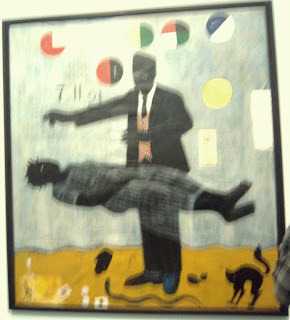
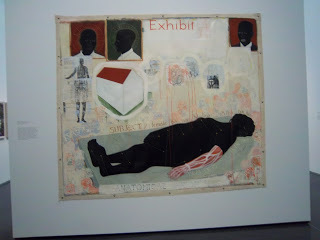
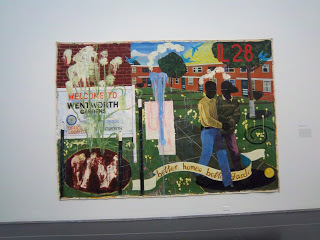

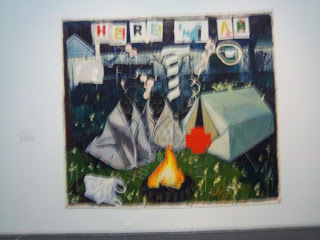
The MCA started as a place to house temporary exhibits of contemporary art. It is still filling that mission housing painting, sculpture, and performing arts. It is the rehearsal space for Eighth Blackbird and we were lucky to get there in time to hear part of their practice. The museum has a theater where various performances are given.
A major retrospective show of Kerry James Marshall’s work is the MCA’s main art exhibit now and will be there through September 25th. I highly recommend that you see this exhibit. Kerry Marshall, an African-American artist, was born in 1955. The exhibit spans Mr. Marshall’s work from 1980 through the present. He believes in becoming versed in all schools of art so that one can adapt diverse ideas and use them to express one’s own. It’s fascinating to see how he blends these ideas producing a wide variety of work.
At the beginning of his career, Marshall’s tones were flat. Later on, his colors became more textured, the people less one-dimensional. For Marshall, black is a color. He has been a very prolific and versatile artist changing styles that he has done over the decades throughout his career.
As we took in the exhibit, many paintings stood out. In fact, they are all noticeable. Mr. Marshall riffed on The Invisible Man working on extra-large canvases so that they couldn’t possibly be ignored. Most of his paintings are anything but invisible. All the people in his paintings are African-American and in fact, race and Black identity is both the main theme and subtext of his works. His view is that by stereotyping all African-Americans to the point that we don’t see each African-American as an individual, white Americans have rendered individual black Americans invisible. By painting individual, diverse African-Americans in all kinds of settings, he turns the stereotypes on their heads. Go see this exhibit and let your perceptions and preconceived ideas be challenged.
Following is a sample of a few paintings you will see at the exhibit. There are many more worth viewing.





Published on May 12, 2016 06:00
May 5, 2016
What to Do in A World Made of Dust
And the war goes on. In Syria, in Iraq, and in Afghanistan. Reading the newspaper today and most days reminds me of a quote I found at the beginning of Trinity by Leon Uris. “There is no present and no future, just the past happening over and over again now.” Trinity is a fictionalized history of the conflict between the Catholics and Protestants in Northern Ireland. Yet, the persistence of that seemingly never ending conflict bore many similarities to the conflicts in the Middle East.
Day after day, we read about the conflicts in Afghanistan, Syria, Israel, Palestine and other parts of that region of the world wondering if perhaps the paper reran a previous issue. It seems to be always the same – more tragedies, more deaths that go on with nothing being resolved.
It was against this backdrop that by chance, I came across A Girl Made of Dust by Nathalie Abi-Ezzi. This book was a great surprise. I picked it up from the Skokie Library paperback book sale shelf to take on a trip to Florida. Since I am pretty low-tech, this is how I get my travel reading material. Sometimes I end up reading things I'd never read otherwise and sometimes I read gems. This is one of them.
I had never heard of Nathalie Abi-Ezzi, but now that I've read A Girl Made of Dust, I will look for her other books. The backdrop of the book is Lebanon in the early 1980's during the war with Israel and several factions within Lebanon some of whom sided with Israel and some who fought against them. Ten-year old Ruba and her family spend their lives dodging bullets, bombs, and shrapnel as they try to survive, living their lives as normally as they possibly can. Her father suffers from PTSD due to a war experience and the whole family is thrown into chaos as a result.
Previously, Ruba’s village had been a mixed one of Muslims and Christians who got along with each other. Now most of the Muslims have been banished. Only Ruba’s friend Kareem remains there, subject to jeers and hatred from the other villagers. Without giving away the plot, I recommend this book. It will undoubtedly make you think twice before advocating getting America embroiled in any more wars in the Middle East.
The only good news in all this is that the conflict in Ireland finally did end when two women, one Catholic Mairead Corrigan Maguire and one Protestant Betty Williams Perkins led a movement to end those hostilities. That year, they were the much deserving winners of the Nobel Peace Prize. “There is no present and no future, only the past happening over and over again now.” When is it going to end?
Day after day, we read about the conflicts in Afghanistan, Syria, Israel, Palestine and other parts of that region of the world wondering if perhaps the paper reran a previous issue. It seems to be always the same – more tragedies, more deaths that go on with nothing being resolved.
It was against this backdrop that by chance, I came across A Girl Made of Dust by Nathalie Abi-Ezzi. This book was a great surprise. I picked it up from the Skokie Library paperback book sale shelf to take on a trip to Florida. Since I am pretty low-tech, this is how I get my travel reading material. Sometimes I end up reading things I'd never read otherwise and sometimes I read gems. This is one of them.
I had never heard of Nathalie Abi-Ezzi, but now that I've read A Girl Made of Dust, I will look for her other books. The backdrop of the book is Lebanon in the early 1980's during the war with Israel and several factions within Lebanon some of whom sided with Israel and some who fought against them. Ten-year old Ruba and her family spend their lives dodging bullets, bombs, and shrapnel as they try to survive, living their lives as normally as they possibly can. Her father suffers from PTSD due to a war experience and the whole family is thrown into chaos as a result.
Previously, Ruba’s village had been a mixed one of Muslims and Christians who got along with each other. Now most of the Muslims have been banished. Only Ruba’s friend Kareem remains there, subject to jeers and hatred from the other villagers. Without giving away the plot, I recommend this book. It will undoubtedly make you think twice before advocating getting America embroiled in any more wars in the Middle East.
The only good news in all this is that the conflict in Ireland finally did end when two women, one Catholic Mairead Corrigan Maguire and one Protestant Betty Williams Perkins led a movement to end those hostilities. That year, they were the much deserving winners of the Nobel Peace Prize. “There is no present and no future, only the past happening over and over again now.” When is it going to end?
Published on May 05, 2016 06:00
April 28, 2016
Traveling In Chicago - Touring In Our Own Backyard
Years ago our cousin Naomi Rushakoff gave us the book Chicago’s Museum’s- A Complete Guide to the City’s Cultural Attractions by Victor J. Danilov. At that time, our lives were incredibly hectic. I thanked Naomi for the book and put it on the bookshelf never to be looked at again. A conversation with my son and daughter-in-law a few days ago about interesting yet obscure Chicago places reminded me of Chicago’s Museums and I decided to take a look at it.
It’s entirely fitting that Naomi gave this book to us. She was a person of infinite enthusiasm for interesting activities and places both famous and obscure, near and far. When my children were growing up, they loved to visit her and her husband Bill because she would find fascinating places to take them that no one else would have thought of. Knowing Naomi, she probably read the book and got a few more local travel ideas. She never seemed to run out of them.
In the desire to channel at least a bit of Naomi’s enthusiasm, I’ve made a goal of visiting many of the places featured in the book. The book was written in 1987 and updated in 1991. Since then, some places in it have been closed and others not mentioned in the book have been opened. All in all, however, Chicago's Museums is a good place to start getting travel suggestions. When traveling to foreign cities, it’s often interesting to go to some places less traveled. Why not do it in my own city?
Since this past Sunday was a beautiful day with summery temperatures, we chose one of the outdoor attractions – North Park Village Nature Center. Although I had driven past the entrance countless times wondering what was inside, I had never actually been in there.
The North Park Village Nature Center and Preserve, situated in the North Park Village complex, was originally the site of the Municipal Tuberculosis Sanitarium. It was closed in 1974 due to the decline in cases of tuberculosis. Now the complex that is owned by the Chicago Park District is home to a senior housing complex, park district field house and gym, and a 46- acre nature area complete with trails and a nature center.
It’s amazing that this site in the middle of a busy city neighborhood could be so tranquil. Such a large area set aside for nature is really a treasure. On the trail, we saw several deer, geese, and ducks. We were told that other animals have been sighted there at other times. We also saw that they are in the process of restoring the habitat. I’m sure if we go there several months from now, we’ll see even more. Now that we know it’s there, I’m sure we’ll be back. These are just some of the pictures that I took of the Nature Center. If you’re looking for a respite from the bustle of city life, this is definitely a place to go.


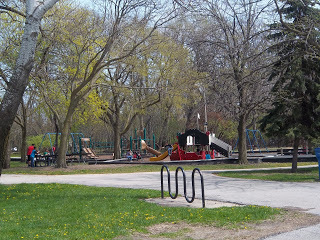 playground near the North Park Village Nature Center
playground near the North Park Village Nature Center 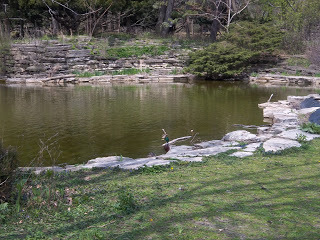 duck pond
duck pond
Published on April 28, 2016 06:00
April 21, 2016
"Let's Talk At Lunch"
Can We Bridge the Racial Divide?
Yesterday I participated in a discussion run and sponsored by the Evanston YWCA (www.ywca.org/Evanston) at the Skokie Library entitled “Let’s Talk At Lunch.” The purpose of the discussion was to share our feelings about race relations and thus arrive at a better understanding among us. Whenever I attend any discussion on race, my instinctive reaction is usually, “Really? We did this in the ‘60’s. Why haven’t we solved it yet?” I’ve learned to keep that thought to myself, however, as I’m reminded almost daily how far America still has to travel to achieve a society free of racism. That said, I commend the YWCA for facilitating these discussions around town. Any efforts made to end racism are a step in the right direction.
One stark reminder of America’s endemic racism that we had recently is the current exhibit -30 Americans -at the Cincinnati Art Museum (www.cincinnatiartmuseum.org).
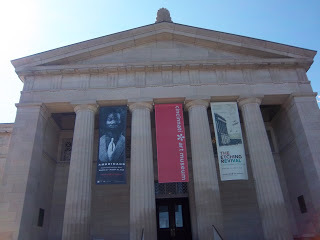 Cincinnati Art MuseumThe exhibit is running through August 28th and is well worth seeing. The exhibit showcases the artwork of 30 African-American artists. What stands out at first glance is the diversity of their work. None of the artists’ works were in the same style as any other, reminding people viewing the exhibit that each artist and in fact, each African-American is an individual. The issue of stereotyping was treated by each artist in his or her own way. Other paintings were portraits and abstracts.
Cincinnati Art MuseumThe exhibit is running through August 28th and is well worth seeing. The exhibit showcases the artwork of 30 African-American artists. What stands out at first glance is the diversity of their work. None of the artists’ works were in the same style as any other, reminding people viewing the exhibit that each artist and in fact, each African-American is an individual. The issue of stereotyping was treated by each artist in his or her own way. Other paintings were portraits and abstracts.
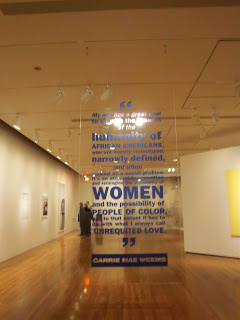 Carrie Mae Weems on Stereotyping
Carrie Mae Weems on Stereotyping
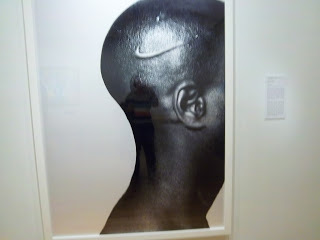 Branded HeadWhen I thought we had seen the whole exhibit, we were directed to the last picture. As we walked into the, I looked and was speechless. In a bare room in which a circle of pointed Ku Klux Klan hats are sitting in a circle, another hangs from a noose reminiscent of lynchings. Once again, we’re reminded that the fight isn’t over. We left the exhibit breathless.
Branded HeadWhen I thought we had seen the whole exhibit, we were directed to the last picture. As we walked into the, I looked and was speechless. In a bare room in which a circle of pointed Ku Klux Klan hats are sitting in a circle, another hangs from a noose reminiscent of lynchings. Once again, we’re reminded that the fight isn’t over. We left the exhibit breathless.
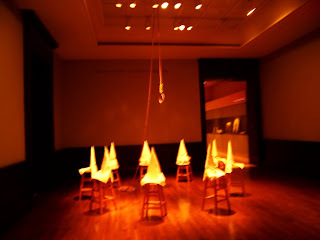 Duck, Duck, Noose
Duck, Duck, Noose
I’m sure this art exhibit was the catalyst for many discussions. If you need a to see something more light-hearted to decompress after seeing it, the Cincinnati Art Museum has many other exhibits, some permanent and some temporary. The museum is small compared to art museums in larger cities but it changes its exhibits frequently. Whenever we’re in Cincinnati, we visit the museum and always see something new there.
There’s always hope also that someday we will see a city or world without racism or other isms that artificially divide us. Until that day, it is good to see that efforts are being made to bring it about.
Yesterday I participated in a discussion run and sponsored by the Evanston YWCA (www.ywca.org/Evanston) at the Skokie Library entitled “Let’s Talk At Lunch.” The purpose of the discussion was to share our feelings about race relations and thus arrive at a better understanding among us. Whenever I attend any discussion on race, my instinctive reaction is usually, “Really? We did this in the ‘60’s. Why haven’t we solved it yet?” I’ve learned to keep that thought to myself, however, as I’m reminded almost daily how far America still has to travel to achieve a society free of racism. That said, I commend the YWCA for facilitating these discussions around town. Any efforts made to end racism are a step in the right direction.
One stark reminder of America’s endemic racism that we had recently is the current exhibit -30 Americans -at the Cincinnati Art Museum (www.cincinnatiartmuseum.org).
 Cincinnati Art MuseumThe exhibit is running through August 28th and is well worth seeing. The exhibit showcases the artwork of 30 African-American artists. What stands out at first glance is the diversity of their work. None of the artists’ works were in the same style as any other, reminding people viewing the exhibit that each artist and in fact, each African-American is an individual. The issue of stereotyping was treated by each artist in his or her own way. Other paintings were portraits and abstracts.
Cincinnati Art MuseumThe exhibit is running through August 28th and is well worth seeing. The exhibit showcases the artwork of 30 African-American artists. What stands out at first glance is the diversity of their work. None of the artists’ works were in the same style as any other, reminding people viewing the exhibit that each artist and in fact, each African-American is an individual. The issue of stereotyping was treated by each artist in his or her own way. Other paintings were portraits and abstracts.
 Carrie Mae Weems on Stereotyping
Carrie Mae Weems on Stereotyping Branded HeadWhen I thought we had seen the whole exhibit, we were directed to the last picture. As we walked into the, I looked and was speechless. In a bare room in which a circle of pointed Ku Klux Klan hats are sitting in a circle, another hangs from a noose reminiscent of lynchings. Once again, we’re reminded that the fight isn’t over. We left the exhibit breathless.
Branded HeadWhen I thought we had seen the whole exhibit, we were directed to the last picture. As we walked into the, I looked and was speechless. In a bare room in which a circle of pointed Ku Klux Klan hats are sitting in a circle, another hangs from a noose reminiscent of lynchings. Once again, we’re reminded that the fight isn’t over. We left the exhibit breathless. Duck, Duck, Noose
Duck, Duck, NooseI’m sure this art exhibit was the catalyst for many discussions. If you need a to see something more light-hearted to decompress after seeing it, the Cincinnati Art Museum has many other exhibits, some permanent and some temporary. The museum is small compared to art museums in larger cities but it changes its exhibits frequently. Whenever we’re in Cincinnati, we visit the museum and always see something new there.
There’s always hope also that someday we will see a city or world without racism or other isms that artificially divide us. Until that day, it is good to see that efforts are being made to bring it about.
Published on April 21, 2016 06:00



